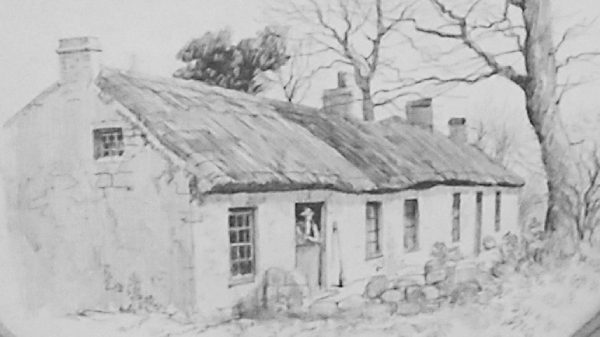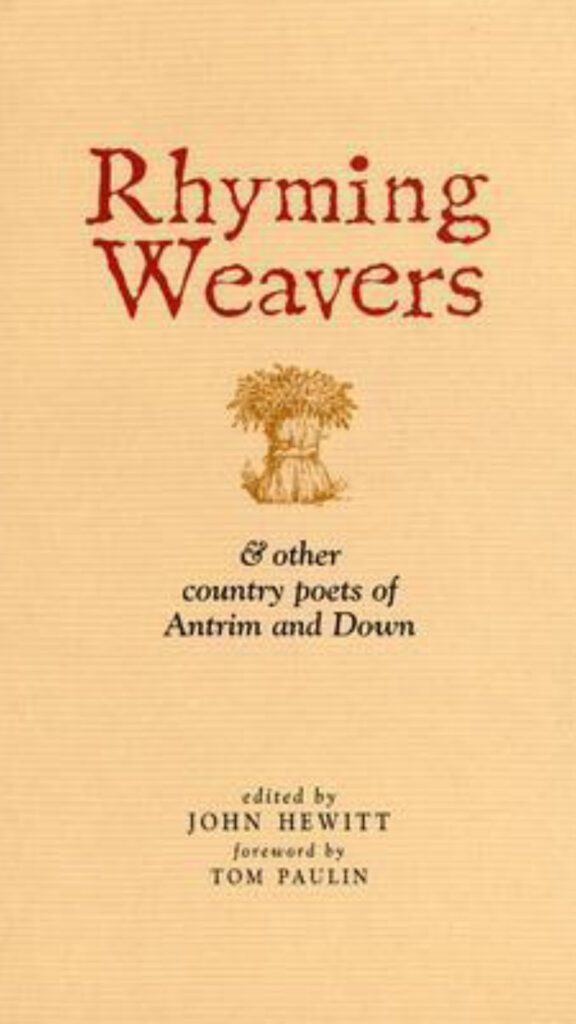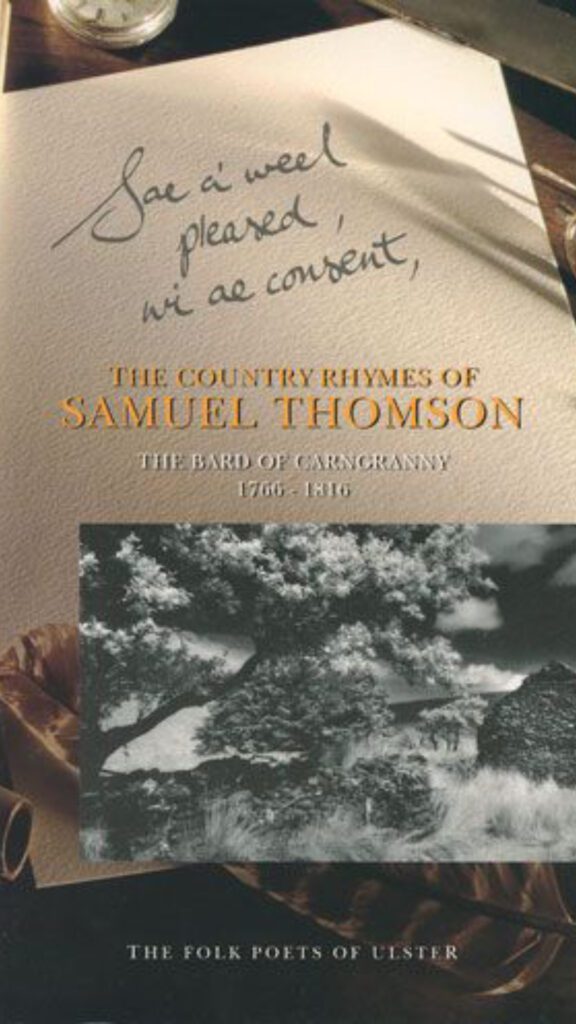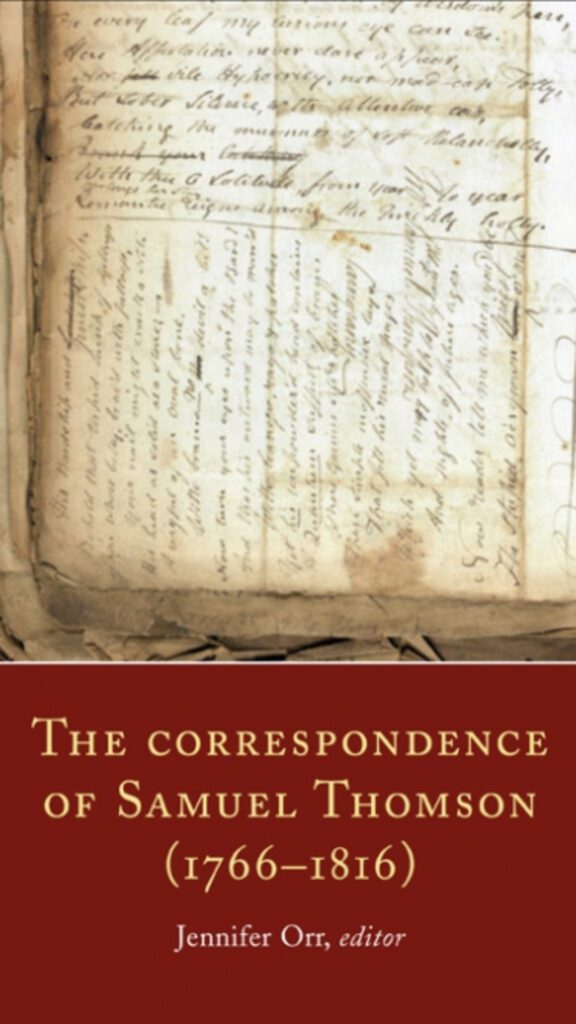An introduction to Samuel Thomson
By Lolly Spence
Samuel Thomson (1766-1816) was a County Antrim poet who has since become known both as the ‘Father of the Rhyming Weavers’ and as ‘The Bard of Carngranny’. The Rhyming Weavers – or Weaver Poets – is a collective term for a group of poets who mostly wrote during the 18th and 19th centuries. Many of them were engaged in the linen trade which flourished in Ulster at the time: however, not all of them were weavers including Samuel Thomson who was a hedge schoolteacher.
His home was in the townland of Carngranny – near the market town of Templepatrick in County Antrim, in the area of the Sixmilewater valley. He lived in a small, thatched cottage on the northern side of Lyle’s Hill, eighteen miles to the north of Belfast. Here, he taught pupils by day and entertained friends in his spare time. Nothing is known of his parents or siblings, and he never married.

Humorously, he named his two-roomed cottage ‘Crambo Cave’: Crambo was a popular and skilful contemporary rhyming game where each participant would in turn compose verse by exhaustively rhyming a particular word, ex tempore. Thomson’s cottage was a centre of creativity for budding poets, and he, as a teacher and writer, guided and inspired them. His intellectual edge as a schoolmaster, and his wide-ranging education gave him a measure of respect amongst his peers. In his own first collection of poems, he name-checks authors he has read:
Homer I’ve read and Virgil too,
With Horace, Milton, Young and Gay,
Auld Spencer, Pope and Dryden thro’,
Sweet Thomson, Shenstone, Goldsmith, Gray
(though he notes that he has only read Homer and Virgil in translation).
Thomson was equally confident writing in both English and Ulster-Scots, and his encouragement of other writers to do the same is why he has been described as the ‘Father of the Rhyming Weavers’ and is recognised as one of the first to fan the flame of an independent tradition of Ulster-Scots poetry.
‘A little rustic Arcadia’ developed in mid-Antrim as Samuel Thomson and his friends met to discuss contemporary events, to write poetry and encourage each other. This was a time when Book Clubs and Reading Societies flourished and Samuel Thomson was a member of The Four Towns Book Club, along with other poets including Thomas Beggs, James Campbell, and Samuel Turner. Members were a diverse mixture of tutors and teachers, landowners, local ministers, and labouring-class weavers; and the library shelves included works by classic writers and contemporary poets such as William Wordsworth, Oliver Goldsmith, George Crabbe, and Thomas Gray.
The subject matter of these ‘Romantic Poets’ often touched on landscape and social conditions, the concerns of the rural poor – and such sentiments found an echo in the Antrim writers as they adopted Romantic verse forms to describe the inequalities and landlord abuses endemic in Ireland at the time.
The late 18th century was an Age of Revolutions. Samuel Thomson was just a boy of 9 when the American War of Independence began; and he was in his 20s when the French Revolution broke out. In 1791, when Thomson was 25, The Society of United Irishmen was formed, and he had great empathy with their ideas of liberty, equality, and fraternity.
The United Irishmen disseminated their views and ideals in a newspaper called ‘The Northern Star’ and it was in this paper that Samuel Thomson first had a poem published in 1792. He continued to send in pieces for publication – often voicing his social and political concerns for the oppressed working classes, rural hardship, and landlord severity. His numerous contributions led to Thomson being described as ‘practically the poet laureate’ of the Northern Star. Eventually the paper was suppressed by the militia in 1797.
Outside his social circle of visitors and pupils, Samuel Thomson had a diverse group of correspondents with whom he exchanged letters. Ninety-six of these original letters have been collected and edited by Dr Jennifer Orr, together with almost fifty original poems. These are available to read in an excellent volume called ‘The Correspondence of Samuel Thomson 1766-1816’ published by the Four Courts Press.



Much has been made of the fact that Samuel Thomson corresponded with the Scottish poet, Robert Burns. They not only wrote to each other but met face-to-face when Thomson travelled to Scotland in 1794 – probably one of the highlights of his life. He visited Burns at home in Dumfries and received several original poems as a gift.
Six years after Robert Burns brought out his first volume of poetry in Kilmarnock, Samuel Thomson became the first Ulster vernacular poet to publish a book of poetry in 1793. He dedicated this volume, ‘Poems on Different Subjects, partly in the Scottish dialect’, to none other than ‘Mr Robert Burns, the celebrated Ayrshire poet’. To publish this book, Thomson had secured about 350 subscriptions, mostly from Antrim and Belfast, including local book clubs, but with others from Dublin and Boston, USA. This collection proved very popular, and Thomson continued to submit material to Belfast newspapers and journals.
As a Presbyterian, Thomson had connections with a number of prominent radicals, involved in the United Irish movement of the 1790s. These included James ‘Jemmy’ Hope, who fought with the Antrim leader, Henry Joy McCracken, during the 1798 Rebellion; and Hope’s brother-in-law Luke Mullan, a weaver and aspiring poet with whom Thomson corresponded at length during the 1790s.
Also present at the Battle of Antrim was the Bard of Ballycarry, James Orr. He and Thomson had a close friendship as fellow members of the Four Towns Book Club (and later the Roughfort Reading Society) and as talented poets. They respected and encouraged each other’s poetic abilities.
Following the failed Rebellion, James Orr fled to Philadelphia. This was a time when Thomson witnessed first-hand the fallout from the insurrection – some of his close friends were killed on the battlefield, others were executed, and some went into exile. The Act of Union followed in 1801 and the political landscape changed. Samuel Thomson’s radical politics gave way to an evangelical Christian spiritualism instead, and this is reflected in his poetry.
In 1803, James Orr returned to Antrim and dedicated a verse epistle to his old friend, Sam Thomson. They began to correspond more regularly – but it seems that Orr did not always reply quickly enough, and Thomson became prickly. This following extract (a letter from James Orr to Samuel Thomson) is a humble apology:
“I am glad, my good friend, that you sent the angry note to me; for tho I felt hurt by the perusal of it, it has a chance to make me more attentive to you… but on receipt of your note I thought I would send this packet to inculpate myself as well as I could from the charge of estranged friendship which you were about to bring against me. …
Write soon my worthy Sir; – after the deserv’d nettling you have given me, you may believe you’ll seldom find me a procrastinating correspondent again.
I have the honour to be your unchanged and I hope unchangeable friend and servant,
J. Orr”
Samuel Thomson published another two volumes of poetry in 1799 and 1806. About 300 friends and local people, mostly from Belfast and County Antrim, subscribed to ‘New Poems’ in 1799; and ‘Simple Poems’ in 1806 had 600 subscribers including an increased number from North Down. Thomson’s complete corpus of over 200 poems reveals a humorous, insightful, patriotic, observant, and occasionally sentimental character.
In May 1816, Samuel Thomson died at the relatively young age of 50, and was buried in an unmarked grave, lost, and largely forgotten.

Lolly Spence
Lolly Spence was a BBC producer for 15 years, before establishing her two businesses, Stone Circle Consulting and Hidden Ulster Tours. Based in County Down, she is a professional tour guide, but also finds time for writing, tutoring, media consultancy, TV presenting, public speaking and local history.






